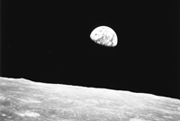
The crew of Apollo 8 delivers a live, televised Christmas Eve broadcast after becoming the first humans to orbit another space body.
Frank Borman, Jim Lovell, and William Anders made their now-celebrated broadcast after entering lunar orbit on Christmas Eve, which might help explain the heavy religious content of the message. After announcing the arrival of lunar sunrise, each astronaut read from the book of Genesis. The astronauts were clearly moved: “The vast loneliness is awe-inspiring, and it makes you realize just what you have back there on Earth,” Lovell said during another broadcast. (There were six broadcasts in all from the crew.)

But admiring the vastness of space was not Apollo 8’s primary mission. This was a pivotal step on the way to the ultimate goal of landing a man on the moon, achieved less than a year later (see here). During a flight lasting six days and including ten orbits of the moon, the Apollo 8 astronauts photographed the lunar surface in detail, both the near and far side, and tested equipment for later missions. The Apollo 8 command module is now on display at Chicago’s Museum of Science and Industry.
The very first Christmas Eve broadcast was 1906 and is generally considered the first public voice-over-radio broadcast of any kind. Canadian inventor Reginald Fessenden was promoting his alternator-transmitter to potential buyers of his patent rights. Like Apollo 8’s, Fessenden’s broadcast was of a pious nature. There was a reading from Luke, chapter 2, and Fessenden himself played “O Holy Night” on the violin. Fessenden’s program was available to anyone with a receiver within range of his transmitter in Brant Rock Station, south of Boston. Unlike Apollo 8’s, his audience was pretty small: primarily shipboard radio operators off the coast.—TL